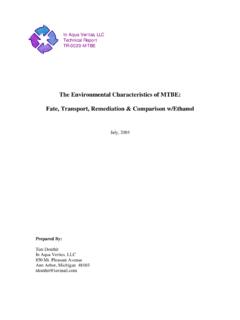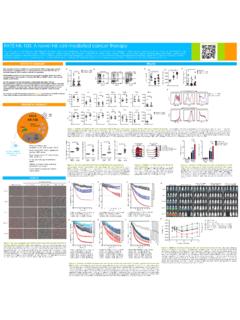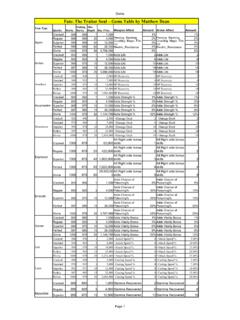Transcription of FATE and DESTINI: A Framework for Cloud Recovery Testing
1 FATEand DESTINI: A Framework for Cloud Recovery TestingHaryadi S. Gunawi, Thanh Do , Pallavi Joshi, Peter Alvaro, Joseph M. Hellerstein,Andrea C. Arpaci-Dusseau , Remzi H. Arpaci-Dusseau , Koushik Sen, and Dhruba Borthakur University of California, Berkeley University of Wisconsin, Madison FacebookAbstractAs the Cloud era begins and failures become com-monplace, failure Recovery becomes a critical factor inthe availability, reliability and performance of Cloud ser-vices. Unfortunately, Recovery problems still take place,causing downtimes, data loss, and many other propose a new Testing Framework for Cloud Recovery :FATE(Failure Testing Service) andDESTINI(Declara-tive Testing Specifications).
2 WithFATE, Recovery is sys-tematically tested in the face of multiple failures. WithDESTINI, correct Recovery is specified clearly, concisely,and have integrated our Framework toseveral Cloud systems ( , HDFS [33]), explored over40,000 failure scenarios, wrote 74 specifications, found16 new bugs, and reproduced 51 old IntroductionLarge-scale computing and data storage systems, includ-ing clusters within Google [9], Amazon EC2 [1], andelsewhere, are becoming a dominant platform for anincreasing variety of applications and services. These Cloud systems comprise thousands of commodity ma-chines (to take advantage of economies of scale [9,16])and thus require sophisticated and often complex dis-tributed software to mask the (perhaps increasingly)poor reliability of commodity PCs, disks, and memo-ries [4,9,17,18].
3 A critical factor in the availability, reliability, and per-formance of Cloud services is thus how they react to fail-ure. Unfortunately, failure Recovery has proven to bechallenging in these systems. For example, in 2009,a large telecommunications provider reported a seriousdata-loss incident [27], and a similar incident occurredwithin a popular social-networking site [29]. Bug repos-itories of open-source Cloud software hint at similar re-covery problems [2].Practitioners continue to bemoan their inability to ad-equately address these Recovery problems. For exam-ple, engineers at Google consider the current state ofrecovery Testing to be behind the times [6], while oth-ers believe that large-scale Recovery remains underspec-ified [4].
4 These deficiencies leave us with an importantquestion: How can we test the correctness of Cloud sys-tems in how they deal with the wide variety of possiblefailure modes?To address this question, we present two advance-ments in the current state-of-the-art of Testing . First, weintroduce FATE(Failure Testing Service). Unlike exist-ing frameworks where multiple failures are only exer-cised randomly [6,35,38], FATEis designed tosystemat-icallypush Cloud systems into many possible failure sce-narios. FATE achieves this by employingfailure IDsas anew abstraction for exploring failures. Using failure IDs,FATEhas exercised over 40,000 unique failure scenarios,and uncovers a new challenge: the exponential explosionof multiple failures.
5 To the best of our knowledge, weare the first to address this in a more systematic way thanrandom approaches. We do so by introducing novel pri-oritization strategies that explore non-similar failure sce-narios first. This approach allows developers to exploredistinct Recovery behaviors an order of magnitude fastercompared to a brute-force , we introduce DESTINI(Declarative TestingSpecifications), which addresses the second half of thechallenge in Recovery Testing : specification of expectedbehavior, to support proper Testing of the Recovery codethat is exercised by FATE. With existing approaches,specifications are cumbersome and difficult to write, andthus present a barrier to usage in practice [15,24,25,32,39].
6 To address this, DESTINI employs a relational logiclanguage that enables developers to write clear, concise,and precise Recovery specifications; we have written 74checks, each of which is typically about 5 lines of addition, we present several design patterns to help de-velopers specify Recovery . For example, developers caneasily capture facts and build expectations, write spec-ifications from different views ( , global, client, dataservers) and thus catch bugs closer to the source, expressdifferent types of violations ( , data-loss, availability),and incorporate different types of failures ( , crashes,network partitions).
7 The rest of the paper is organized as follows. First,we dissect Recovery problems in more detail ( 2). Next,we define our concrete goals ( 3), and present the designand implementation of FATE( 4) and DESTINI( 5). Wethen close with evaluations ( 6) and conclusion ( 7).1 Appears in the Proceedings of the 8th USENIX Symposium on Networked Systems Design and Implementation (NSDI 11)2 Extended Motivation: Recovery ProblemsThis section presents a study of Recovery problemsthrough three different lenses. First, we recap accountsof issues that Cloud practitioners have shared in the lit-erature ( ). Since these stories do not reflect details,we study bug/issue reports of modern open-source cloudsystems ( ).
8 Finally, to get more insights, we dissecta failure Recovery protocol ( ). We close this sectionby reviewing the state-of-the-art of Testing ( ). Lens #1: Practitioners ExperiencesAs well-known practitioners and academics have stated: the future is a world of failures everywhere [11]; re-liability has to come from the software [9]; recoverymust be a first-class operation [8]. These are but aglimpse of the urgent need for failure Recovery as we en-ter the Cloud era. Yet, practitioners still observe recoveryproblems in the field. The engineers of Google s Chubbysystem, for example, reported data loss on four occasionsdue to database Recovery errors [5].
9 In another paper,they reported another imperfect Recovery that broughtdown the whole system [6]. After they tested Chubbywith random multiple failures, they found more prob-lems. BigTable engineers also stated that Cloud sys-tems see all kinds of failures ( , crashes, bad disks,network partitions, corruptions, etc.) [7]; other practi-tioners agree [6,9].They also emphasized that, ascloud services often depend on each other, a recoveryproblem in one service could permeate others, affect-ing overall availability and reliability [7]. To conclude, Cloud systems facefrequent,multipleanddiversefail-ures [4,6,7,9,17].
10 Yet, Recovery implementations arerarely tested with complex failures and are not rigorouslyspecified [4,6]. Lens #2: Study of Bug/Issue ReportsThese anecdotes hint at the importance and complex-ity of failure handling, but offer few specifics on howto address the problem. Fortunately, many open-sourcecloud projects ( , ZooKeeper [19], Cassandra [23],HDFS [33]) publicly share in great detail real issues en-countered in the field. Therefore, we performed an in-depth study of HDFS bug/issue reports [2]. There aremore than 1300 issues spanning 4 years of operation(April 2006 to July 2010).











